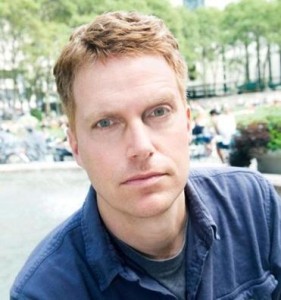Article by Jordan Kaye
New York City is as close as it ever has been (maybe as close as it ever will be) to fulfillment of a certain vision for urban utopia: cultural landmarks, sprawling waterfront parkland, and hyper-gentrified neighborhoods linked up by a single hot-button bike lane, made possible by a willful capitalist mayor and a big, fat wad of banker cash. It’s tempting, then, to pile writer Adam Sternbergh’s Shovel Ready – a novel that imagines a city brought low by exaggerated versions of all of the Great Recession’s big disasters, showdowns and near misses – on the perilously high stack of adaptation-friendly dystopian stories. The writer offers a particularly frightening view of New York to anyone who has invested in real estate here at any time since the Dinkins administration.

Carroll Gardens writer Jordan Kaye
But to anyone who is discomfited, even just a little, by the playground the city has become, the book’s a touch therapeutic.
Sternbergh – a Carroll Gardens resident, and the culture editor of The New York Times Magazine – creates in his debut novel a city in the near future that has survived, if barely, a terrorist bombing in Times Square, and other attacks. Most residents flee the city, leaving behind the rich and the poor.
Sternbergh’s Sandied, Occupied, Dirty-Bombed New York resembles nothing so much as a turned back clock. The streets of Carroll Gardens are pictured as lined with broken window brownstones, boarded up with rotting ply to hide all of that meticulously restored detail. Times Square is reverted to a toxic, plastic bag of tumbleweed  desert, bordered by pre-Uniqlo bodegas. Even the ashen-face nurse that Sternbergh describes as dragging in one cigarette after another over a terminal patient’s bed places us unmistakably in an urban vision inflected by a post-Mad Men / pre-Giuliani wasteland. Everything that Bloomberg worked so hard to achieve (even the smoking bans) erased . . . .
desert, bordered by pre-Uniqlo bodegas. Even the ashen-face nurse that Sternbergh describes as dragging in one cigarette after another over a terminal patient’s bed places us unmistakably in an urban vision inflected by a post-Mad Men / pre-Giuliani wasteland. Everything that Bloomberg worked so hard to achieve (even the smoking bans) erased . . . .
Which puts my question to the narrator: Is this book dystopian, or a schadenfreude’s utopia?
The main character, Spademan, once (“once†meaning, from the novel’s backward looking perspective, right here in 2014 or thereabouts) lived in Carroll Gardens and collected garbage. He was a witness/victim, like virtually every South Brooklyn resident today who doesn’t own a brownstone or condo, of the Great Gentrifipression. In Shovel Ready, all that’s history. Now, Spademan lives in Jersey, and he’s a hit man. Although his personal life was destroyed by one of the dirty bombs that unraveled the city, the reader can’t help but notice a certain grim satisfaction while Spademan takes his bitter hit man beat and observes a city torn asunder.

Author Adam Sternbergh of Carroll Gardens. Photo by Marvin Orellana.
The Occupy crowd has turned Central Park into a joylessly sordid, perpetual Burning Man, and the Bloomberg Gentry have all retreated: either back to the ‘burbs (“where they belong!†we seem to hear Sternbergh muttering) or else tuned into a movie rights-ready virtual reality that Sternbergh calls the limnosphere. We’ve seen the limnosphere before, by many other names, and in many movies: a CGI fantasyland facilitated by a bedside nurse, a catheter, and many electrodes. Spademan’s most graphic and emotionally rewarding murders are inflicted against the rich and escapist while they lie helpless and unconscious inside their equity-drained brownstones on their high speed Internet limnosphere stretchers, addicted, addled and, finally, distracted by a synthetic world comprised of their own tacky Real Housewife fantasies. That’s when their real corpi get shivved by the garbageman hitman Spademan. The renters and worker bees and old timers here in Carroll Gardens might be forgiven for finding this violence a touch cathartic
I know a Carroll Gardens ex-garbage man. And I’ve never heard him refer to himself as a garbageman. He was “in sanitation,†and now he doesn’t kill people, he suns outside the laundromat, living off of a generous city pension. I’m pretty sure he’s sitting on a nice few million in real estate equity, too. (Many, many times, as I have staggered to the laundromat from my inching-toward-market rental burdened by some thirty pounds of playground-stained laundry, this sanitation pensioner and Carroll Gardens real estate magnate has called me very mean things. He’s threatened to run me out of the neighborhood, and to “shove a broom†up my ass. Precisely because it’s me, rather than my wife, who carries the massive loads of laundry back and forth, he calls me “Kitchen Bitch†and a “fucking homo,†which is nostalgic for me because no one has called me that in almost thirty years and it reminds me of my limnosphere/suburban childhood.)
Spademan lacks the wit, the playful nuance of idiom, and the real estate holdings of the only Carroll Gardens former sanitation worker I know. The literary and historical references that sprinkle his narrative are usually followed by some aside that seems to represent an interjected apology from Sternbergh (“Yes, I know the word financier,†Spademan pauses after using the word, “Just don’t ask me to say it out loud.â€) Similar apologies follow the noire clichés (“I know it’s a cliché to be a hard drinker in my profession. It’s the one part I do really well.â€)
Spademan is right on that last point: He doesn’t excel at his job. The only murder he is commissioned to commit during the entirety of the novel never comes off, and he lacks the cunning, the foresight, and even the grotesque proportion of self-destructiveness that characterizes the most compelling noir protagonists in the urban grit genre.
Whatever Spademan’s deficiencies, he’s plainly a man to keep an eye on. A film deal was sold on “Shovel Ready†many months before it’s book release date, and a second Spademan novel is already in the works. And, if purely as a dystopian/cathartic antidote to the NYT Real Estate Section Blues, the book is worth the read.
Jordan Kaye is a writer and legal recruiter. His writing has been published in GQ magazine and his first book, How to Booze: Exquisite Cocktails and Unsound Advice, was published by Harper Collins in 2010. He lives in Carroll Gardens with his wife and children.
